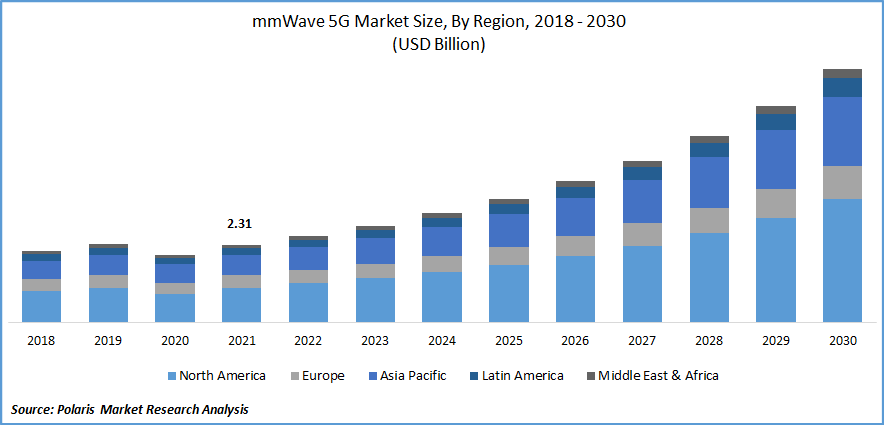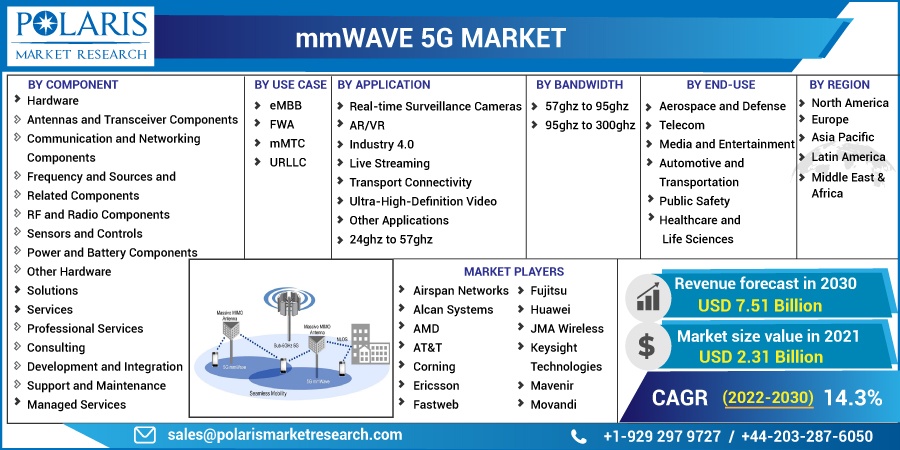
mmWave 5G Market Share, Size, Trends, Industry Analysis Report, By Component; By Use Case (eMBB, FWA, mMTC, URLLC); By Application; By Bandwidth; By End-Use; By Region; Segment Forecast, 2022 - 2030
- Published Date:Oct-2022
- Pages: 118
- Format: PDF
- Report ID: PM2714
- Base Year: 2021
- Historical Data: 2018-2020
Report Outlook
The global mmWave 5G market was valued at USD 2.31 billion in 2021 and is expected to grow at a CAGR of 14.3% during the forecast period. The growing demand for mmWave 5G is expected to be driven by the rising demand for high-speed connectivity and the rapid growth of virtualization in the networking sector.

Know more about this report: Request for sample pages
mmWave 5G is able to transfer a large volume of data more efficiently and offers better bandwidth with less network congestion. In addition, this technology supports more connections without experiencing a substantial decrease in speed, creating demand in crowded areas such as airports, concerts, and events that require better connectivity without any speed drop; such factors are expected to drive market growth over the forecast period.
The COVID-19 pandemic had a negative impact on the growth of the market owing to the government's stringent rules and a temporary halt in spectrum auctions in many countries during that period which hampered the market. Moreover, the deployment of mmWave in various commercial sector were standstill due to the global lockdown, which haltered the market growth.
This technology offers bandwidth ranging from 30GHz -300GHz, which is ultra-fast and performs better with the new application. However, these waves are usually blocked and obscured by buildings, trees, and walls which restrain the market growth. Moreover, deployment of these spectrum waves is also considered a challenge as one has to stay within a block of a 5g tower, which creates a disruption of signal and ultimately hinders the market growth.

Know more about this report: Request for sample pages
Industry Dynamics
Growth Drivers
The global market is likely to be driven by the increasing utilization of smartphones across developed and developing economies and the rising investment of service operators to adopt this technology. mmWave spectrum provides extreme bandwidth, which expands network capacity and offers widespread support for multi-Gbps speeds, which meets the demand for mobile data services and use case requirements such as cloud gaming; such factors are expected to propel the market growth over the forecast period.
The growing demand for mmWave technology due to its several applications in the internet of things (IoT), such as VR/AR, high-quality video, real-time surveillance cameras, and live streaming, is expected to drive market growth.
Furthermore, the rising demand for mmWave 5G in industrial IoT, shared workspaces, and smart manufacturing areas due to its better speed and bandwidth is expected to accelerate the market growth.
Report Segmentation
The market is primarily segmented based on component, use case, application, bandwidth, end-use, and region.
|
By Component |
By Use Case |
By Application |
By Bandwidth |
By End-Use |
By Region |
|
|
|
|
|
|
Know more about this report: Request for sample pages
Hardware segment accounted for the largest share in 2021
The hardware segment accounted for the highest revenue share in 2021 owing to its lightweight and compact structure. The demand for antennae and transceivers was high, which, when incorporated with beamforming frequency, reduced interference, improved signal-to-interference-noise-ratio, and system performance influencing the market growth. Moreover, antennas are gaining more popularity in small IoT devices due to their compact size and higher bandwidth, which is expected to drive segment growth.
Enhanced mobile broadband (eMBB) is expected to lead the market
The enhanced mobile broadband (eMBB) is expected to lead the market growth owing to increasing penetration of mmWave spectrum in the densest part with developed economies and locations where a massive volume of data is produced, such as transport hubs, urban environments, and event venues.
In addition, this network connection supports mission-critical use cases in military operations, healthcare, and manufacturing responses which are expected to drive the demand for the segment over the upcoming years. Moreover, embb provides continue UHD videos, 8k streaming, and immersive event experience driving the market.
AR/VR is expected to grow at a highest CAGR over the forecast period
The demand for AR/VR is expected to surge significantly over the forecast period as it provides better end-to-end latency and user experience when incorporated with mmWave 5G. In addition, AR/VR devices can access and handle huge amounts of data in real-time, which could be used for outdoor environments without depending on a Wi-Fi source which is expected to drive market growth.
The emerging edge cloud technology and mmWave 5G has created a lucrative opportunity for the segment where lightweight goggles and smaller headsets with wireless connection are expected to have a positive impact on the market growth over the forecast period.
95GHz to 300GHz is expected to dominate the market
95GHz to 300GHz bandwidth is expected to dominate the market over the forecast period owing to the increasing demand for internet services in commercial and residential sectors, which require high bandwidth and ultra-high reliability. Moreover, this frequency is considered to replace the frequency of fiber optics due to the low signal loss, which is expected to accelerate market growth.
Telecom is expected to be the fastest-growing segment
The Telecom industry is expected to be the fastest-growing segment over the forecast period with the adoption of mmWave technology in smartphones and telecom infrastructure. Furthermore, rising demand for high-speed data transfer from various commercial sectors, such as IT offices, is expected to drive market growth.
The aerospace and defense segment is the second largest segment to grow over the forecast period owing to the extensive utilization of mmWave technology for better connectivity of the tactical network, security, and electronic warfare. Moreover, the demand for mmWave is rising due to its several applications to improve inter-satellite links and point-to-point communications, which is expected to drive market growth.
North America is expected to dominate and witness fastest growth over the forecast period
North America is the largest region for mmWave 5G and is expected to witness faster growth over the forecast period owing to the adoption of millimeter wave technology by key market players across the countries. In addition, many commercial and telecom industries investing in developing mmWave 5G technology that can manage massive digital traffic is expected to drive demand over the forecast period.
Asia Pacific is expected to be the second largest region due to rapid digitization and consumer shift from LTE to 5g network. In addition, this technology, when incorporated with artificial intelligence and augmented reality, has provided solutions in the healthcare sector, such as a doctor explaining to patients with virtual reality for better interaction and understanding.
Furthermore, IoT and cloud technologies solutions for the public sector are likely to have a positive impact on revenue growth.
Competitive Insight
Some of the major players operating in the global market include Airspan Networks, Alcan Systems, AMD, AT&T, Corning, Ericsson, Fastweb, Fujitsu, Huawei, JMA Wireless, Keysight Technologies, Mavenir, Movandi, Nokia, NTT Docomo, NXP Semiconductors, Pharrowtech, Pivotal Commware, Qualcomm, Rakuten Mobile, Renesas Electronics Coerporation, Samsung, Singtel, Sivers Semiconductors, Softbank, Verana Networks, Verizon Communications Inc.
Recent Developments
In February 2022, Fastweb and Qualcomm Technologies collaborated to commercialize mmWave 5G services in Italy using snapdragon X65 and X62, which will have access to residential and commercial customers.
In January 2022, Nokia and SK telecom collaborated on a new wireless-based virtualized RAN network in Korea. It has a large-capacity computing flexible network and performs better than the previous versions.
mmWave 5G Market Report Scope
|
Report Attributes |
Details |
|
Market size value in 2022 |
USD 2.57 billion |
|
Revenue forecast in 2030 |
USD 7.51 billion |
|
CAGR |
14.3% from 2022 - 2030 |
|
Base year |
2021 |
|
Historical data |
2018 - 2020 |
|
Forecast period |
2022 - 2030 |
|
Quantitative units |
Revenue in USD billion and CAGR from 2022 to 2030 |
|
Segments Covered |
By Component, By Use Case, By Application, By Bandwidth, By End-Use, By Region |
|
Regional scope |
North America, Europe, Asia Pacific, Latin America; Middle East & Africa |
|
Key Companies |
Airspan Networks, Alcan Systems, AMD, AT&T, Corning, Ericsson, Fastweb, Fujitsu, Huawei, JMA Wireless, Keysight Technologies, Mavenir, Movandi, Nokia, NTT Docomo, NXP Semiconductors, Pharrowtech, Pivotal Commware, Qualcomm, Rakuten Mobile, Renesas Electronics Coerporation, Samsung, Singtel, Sivers Semiconductors, Softbank, Verana Networks, Verizon Communications Inc. |
